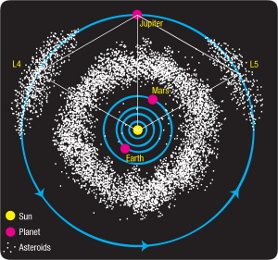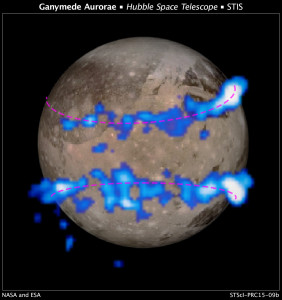Creation Corner
Water beyond the belt

NASA, two days ago (March 12, 2015), confirmed what planet-watchers have known for years. Ganymede, the largest moon of Jupiter, has a thick layer of ice, with an ocean beneath. Ganymede becomes the third large moon in the solar system to harbor such vast amounts of liquid water. And once again, NASA and those who work the Science Beat indulge themselves, speculating about Life Beyond Earth. Well, NASA might have good reason to find life on these three moons. But that reason would never occur to them. The subglacial oceans of Ganymede and Europa (moons of Jupiter) and Enceladus (moon of Saturn), and their respective ice coverings, likely came from Earth. And this water likely brought living things with it.
Large moons of Jupiter and Saturn
Galileo Galilei first discovered the four largest moons of Jupiter: Io, Europa, Ganymede, and Callisto, in order from innermost to outermost. The first three even have a 1:2:4 orbital resonance. All four bodies undergo tidal stresses, as does any large moon. Io comes close enough to Jupiter to pump its insides hot enough for them to melt and erupt in great sulfurous volcanoes. But Europa and Ganymede are far enough away to stay cold.

NASA Hubble Space Telescope images of Ganymede’s auroral belts (colored blue in this illustration) are overlaid on a Galileo orbiter image of the moon. The amount of rocking of the moon’s magnetic field provided evidence that the moon has a subsurface saltwater ocean.
Enceladus, one of the eight largest moons of Saturn, also has a subglacial ocean. But water often spews out in jets rapid enough to turn to plasma. The ESA spacecraft Cassini confirmed this by passing through one of these jets. Cassini confirmed something else: those jets have a salt concentration similar to that of the oceans of earth.
The Christian Science Monitor yesterday carried the story of NASA’s announcement about Ganymede. (Last year they also carried this story about Europa.) Ganymede, unique among planetary satellites, has a magnetic field strong enough to measure. Its magnetic field interacts with that of Jupiter. This produces auroras. These auroras tend to rock, but less than one might suppose from Jupiter’s field alone. Some feature of Ganymede dampens this rocking. The most likely candidate: a subglacial ocean.
NASA calculates Ganymede has a 95-mile thickness of water ice. Deep to this lies a 60-mile-deep liquid water ocean. If those figures hold, Ganymede alone could hold more liquid water than Earth itself. Next question: where did this water come from?
Where did the water come from?
[ezadsense midpost]
Walter T. Brown (Center for Scientific Creation, Phoenix, Ariz.) has long suspected the water and ice of Enceladus came from earth during the Global Flood. He cites the composition of the plasma jets from the Enceladus south pole. He also says he believes Enceladus, as irregular as it is, is a captured asteroid.
Enceladus and Europa share surface features in common: stripe-like markings on the surface. (NASA calls these “tiger stripes” on Enceladus.) The stripes of Europa and Enceladus differ only in their apparent color. Brown believes each of these are seams where water might occasionally escape. This causes the ice to “wrinkle.” The “wrinkles” show up as the stripes.
If the vast subglacial water on Europa, Ganymede and Enceladus came from earth, the original subcrustal ocean of earth held many times the volume of water in the ocean today. Brown has no problem with this. He guessed the subcrustal ocean must be three-quarters of a mile deep. It must be that deep or deeper, to hold enough water to dilute the original surface ocean 1:1. (The average deuterium-to-protium, or D:H, ratio of the comets is about 2:1.) But his Hydroplate Theory never set a limit on the depth of those subcrustal waters.

Cutaway view of Ganymede, showing the latest inferences about Ganymede’s subglacial water. Credit: NASA/ESA/STSci
In fact, he said today, the deeper the subcrustal waters were, the more easily they could have cracked the fifty miles of rock that lay above them. After that, those waters could more easily have eroded the fifty-mile cliff faces for four hundred miles inland, and removed nearly thirty miles of rock from the floor and ceiling of the subcrustal (or intra-mantle) chamber. This produced a heavy jet of water, rock and mud that flew straight up into space. He estimates four percent of the earth’s mass escaped on that day, fifty-three hundred years ago (give or take a hundred). The escaping mass persists as the comets, the asteroids, the meteoroids, and the trans-Neptunian objects. To that he would add the water on Enceladus, Europa, and now Ganymede.
Why have those waters stayed liquid? From tidal pumping. In fact Brown agrees with those who believe the icy covering of Europa is relatively thin. Which would make sense. Europa lies inside Ganymede, with a month half that of Ganymede. The orbits “pump” Europa’s ocean twice as often. Naturally Europa would stay warmer than Ganymede, warm enough to keep its ice thin.
For this reason the mission controllers of the Galileo spacecraft ditched it on Jupiter, so it would never risk cracking the ice on Europa and contaminating the ocean. Brown laughs at the “ethical” reason the controllers gave for the move. But he agrees they had a valid scientific reason: any life in the waters of Europa, or Ganymede, or Enceladus, would come from earth. Better not to introduce such life more recently!
But Brown has little patience for the theory that liquid water originated beyond the “habitable zone.” One should never assume even liquid water originated everywhere one might find it. Especially if the one habitable planet suffered a violent event and spewed out a twenty-fifth part of its mass to the far reaches of its system.
[ezadsense leadout]
Terry A. Hurlbut has been a student of politics, philosophy, and science for more than 35 years. He is a graduate of Yale College and has served as a physician-level laboratory administrator in a 250-bed community hospital. He also is a serious student of the Bible, is conversant in its two primary original languages, and has followed the creation-science movement closely since 1993.
-

 Civilization4 days ago
Civilization4 days agoDC Pipe Bomb Arrest Raises Questions About Christopher’s Wray’s FBI
-

 Civilization5 days ago
Civilization5 days agoThe Legal Logic Behind U.S. Operations Against Narco-Terrorist Networks
-

 Executive5 days ago
Executive5 days agoNewsom’s ‘National Model’ for Homeless Wracked by Fraud
-

 Executive2 days ago
Executive2 days agoWaste of the Day: Obamacare Failed Test, Approved Fraudulent Subsidies
-

 Executive4 days ago
Executive4 days agoWhen You’re in a Hole, Stop Digging
-

 Education3 days ago
Education3 days agoWaste of the Day: Taxpayers Subsidize Football Coach Severance
-

 Civilization3 days ago
Civilization3 days agoPence Calls on Trump To Fire RFK Jr Over Abortion Drug
-

 Civilization3 days ago
Civilization3 days agoRight-Wing Antisemitism, Liberalism, and Leo Strauss













[…] from examiner.com and from Conservative News and […]
I am a little unclear as to why h2o is being claimed to have all originated on earth? (the liquid qualification is just indicative of current temperature/pressure)
There is lots of rock, gases, and other materials that are not being claimed to have come from earth. Why is h2o so special?
There is growing evidence for extra-solar water/ice/vapor, is that all from the Flood as well?
Brown doesn’t claim an earthly origin for extrasolar water. For one thing, we cannot assure ourselves as strongly about extrasolar water as about water on Ganymede and elsewhere on the solar system. For another, one can’t even tell how much water one might find beyond the solar system. But we have good reason to suppose at least some water might have left the solar system, in the form of comets that, once formed, left the solar system along hyperbolic trajectories that never closed. How much, we have no idea.
So does Dr. Brown propose that just the _water ice_ on Ganymede, Europa, and Enceladus is of Earthly origin, or the rocky parts of those bodies as well? Ganymede alone (rock and ice together) is about 2.4% of the mass of Earth; Europa is about 0.8% (rock/ice combined). That’s more than three quarters of the 4% of Earth’s mass Dr. Brown says was launched in the Flood, and it doesn’t leave enough for the rest of the solar system bodies he claims are from Earth. For that matter, Callisto, unmentioned here, is roughly 50% ice by mass; that’s another ~1% of Earth’s mass just in ice or ~2% in ice and rock together. If Ganymede and Europa’s ices are from Earth, is Callisto’s as well? If Enceladus’ ice is from Earth, what about Titan’s?
Let’s suppose that Ganymede and Europa and Enceladus were originally rocky bodies around Jupiter and Saturn, and picked up all their ice from Earth. How much of the ice crossing the orbit of Jupiter and Saturn on its way out to the future Kuiper belt do you suppose was picked up by those _moons_ as opposed to that swept up by Jupiter and Saturn? Do you think it would be safe to say that for every kg of ice picked up by Ganymede, a kg was grabbed by Jupiter? 100 kg? 1000 kg? Roughly speaking, Jupiter exerts 10000 times the gravitational pull that Ganymede does; if I sent a spray of water toward them would it make sense that Jupiter would capture 10000 times as much material as Ganymede would? Perhaps you had a different scenario in mind; one in which a few massive bodies of Earth-water ice just happened to impact on Ganymede, Europa, and Enceladus (and Callisto? Titan? others?) while avoiding their much more massive primaries. Could you explain what the thinking is here?
I’m not sure we’ve heard what the most recent revision of the pre-Flood Earth model is, either: a subcrustal ocean how many miles thick with a roof how many miles deep now? Creationscience.com currently says 50 miles deep (up from 10 miles deep a few weeks ago) and 3/4 of a mile thick, but it sounds like Dr. Brown now has different thoughts about how thick the subcrustal water layer would need to be. How thick would the layer have to be to account for the water on Ganymede, Europa, Enceladus, and whatever other moons? Can rock pillars 5, 10, 20, or 50 miles high bear the weight of 50 miles of rock above them?
Separate Enceladus from the rest, because Enceladus is irregular. Brown proposes that Enceladus formed as an asteroid from Flood ejecta, and Saturn captured it. Not so Europa and Ganymede. The liquid water splashed onto those two bodes. Some of it froze, and that’s the ice we see – a lot thicker on Ganymede than on Europa.
Well, that’s a partial answer, but it’s a place to start from. So Europa and Ganymede were native rocky bodies, and liquid (liquid?) water splashed down on them and froze. Was this a single giant ball of liquid water impacting each moon, or some other arrangement? Did Io and Callisto get the same treatment (Callisto has roughly the same amount of water as Ganymede)? Did Jupiter’s water also come from Earth?
What kind of energy release do you expect from the collision of ~7e22 kg of water with ~7e22 kg of rock (for the Ganymede example) or 3.8e21 kg of water with 4.4e22 kg of rock (the Europa example)?
Not necessarily a single ball of water for each body, but millions of droplets. Or more likely, several dirty snowballs. In short, comets, all of which formed from Flood ejecta.
Furthermore: Mars shows evidence of water splashing down, from above, onto several gully-like formations on the surface. That would be consistent with this proposa, don’t you think?
Io we can’t tell about. Io is so close to Jupiter, it’s too hot to retain water. It’s volcanic, in fact. That’s what the tidal stresses have done to it.
Callisto: sure, why not? And the ice might go through-and-through, since its tidal stresses might be far less.
Here’s another thing to consider: every small moon of the gas giants, the two small “moons” of Mars, and the irregular (that is, non-spheroidal) moons of Saturn (like Enceladus), all are asteroids, either captured after they formed, or formed on-site. The rings might be Flood ejecta that never accreted.
Not sure why you’re picking on Enceladus; it’s one of the seven ellipsoidal moons of Saturn and not particularly irregular; certainly less so than Mimas or Tethys.
Comets crashing into the Jovian and Saturnian satellites to provide them with ice: okay. I will ask again, though: for every droplet or snowball that landed on a moon of a gas giant, how many ended up landing on the primary?
If Earth, which currently has ~1.38e21 kg of water, supplied 7e22 kg of water to Ganymede, and 3e21kg of water to Europa, and 5e22 kg of water to Callisto, and 6.7e22 kg of water to Titan, and who knows how much to Io before it boiled off, and 3e19 kg to Mimas, and 6e20 kg to Tethys, and 6e20 kg to Dione, and 1.7e21 kg to Rhea, and 1.4e21 kg to Iapetus (that’s a running total of ~1.8e23 kg), then how much more did it drop into Jupiter and Saturn directly? Ten times as much? A hundred? Or should we believe that all the cometary material originating from Earth touched down perfectly on the gas giant _satellites_ without any hitting the _gas giants_?
Just the amount of water on the major Jovian and Saturnian satellites would represent an ocean of water covering Earth to a depth of over 300 kilometers. Was the subcrustal ocean 300 km thick?
Pick whatever measure you like – angular size, gravitational attraction, surface area – and it seems inescapable that Jupiter and Saturn would absorb thousands of times the number of comets that would hit their moons. Perhaps you have reason to believe otherwise, though.